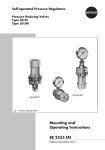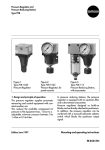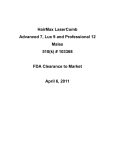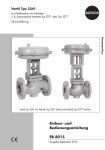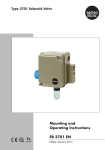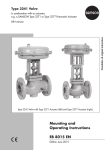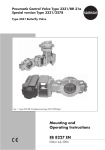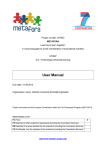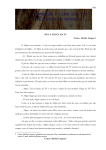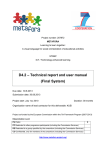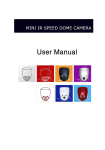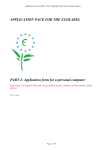Download Mounting and operating instructions EB 8139 EN
Transcript
Angle Seat Valve Type 3353 Fig. 1 ⋅ Type 3353 Mounting and operating instructions EB 8139 EN Edition August 2002 Contents Contents 1. 2. 2.1 3. 3.1 3.2 4. 5. 6. Safety instructions Design and principle of operation Installation . . . . . . . . . . . Signal pressure connection . . . . Maintenance – Replacing parts . Plug seal . . . . . . . . . . . . . Packing . . . . . . . . . . . . . Altering the spring force . . . . . Dimensions in mm . . . . . . . . Customer inquiries . . . . . . . . . . . . . . . . . . . . . . . . . . . . . . . . . . . . . . . . . . . . . . . . . . . . . . . . . . . . . . . . . . . . . . . . . . . . . . . . . . . . . . . . . . . . . . . . . . . . . . . . . . . . . . . . . . . . . . . . . . . . . . . . . . . . . . . . . . . . . . . . . . . . . . . . . . . . . . . . . . . . . . . . . . . . . . . . . . . . . . . . . . . . . . . . . . . . . Page . 3 . 4 . 4 . 4 . 5 . 6 . 8 . 9 . 10 General safety instructions The control valve may only be assembled, started up or serviced by experi 2 EB 8139 EN enced personnel familiar with the product. Employees or third persons must not be exposed to any danger. The control valve fulfills the requirements of the European Pressure Equipment Directive 97/23/EC. Valves with a CE marking have a declaration of conformity that includes information on the applied conformity assessment procedure. The declaration can be found in the appendix of these instructions. For appropriate operation, make sure that the control valve is only used in areas where the operating pressure and temperatures do not exceed the operating values based on the valve sizing data submitted in the order. The manufacturer rejects any responsibility for damage caused by external forces or any other external influence! Any hazards which could be caused in the control valve by the process medium, operating pressure or signal pressure are to be prevented by means of the appropriate measures. Proper shipping and appropriate storage are assumed. Caution! For installation and maintenance work on the valve, make sure the relevant section of the pipeline is relieved of pressure and, depending on the process medium used, drained as well. If necessary, allow the control valve to cool down or warm up to reach ambient temperature prior to starting any work on the valve. When working on the valve, make sure that the pneumatic air supply as well as the control signal are disconnected to prevent any hazards due to moving parts. Design and principle of operation 1. Design and principle of operation The pneumatic control valve consists of a angle seat valve that has a plug with soft sealing and a pneumatic piston actuator. Depending on the version, the actuator can be equipped with a mechanical manual override or an electric limit switch. The control valve is designed for on/off control in process engineering and plants with industrial requirements. It is suitable for liquids, vapors and gases at temperatures from –10 to 180 °C and a nominal pressure of PN 40. The process medium flows through the valve in the direction indicated by the arrow. The signal pressure applied to the piston actuator determines the position of the plug and thus the cross-sectional area of flow between the seat and plug. 1 2 9 13.1 8 13 14 4.1 4.4 The actuator stem (2) is sealed at the valve end by a self-adjusting packing consisting of PTFE V-rings (4.4) and at the actuator end by a shaft sealing ring (4.1). Fail-safe position: The fail-safe position of the control valve when the air supply fails is determined by how the piston and spring are arranged in the actuator. Valve CLOSED (actuator stem extends) The actuator spring closes the valve upon air supply failure. The valve opens as the signal pressure increases. Valve OPEN (actuator stem retracts) The actuator spring opens the valve upon air supply failure. The valve closes as the signal pressure increases. Body Plug with plug/actuator stem 4.1 Shaft sealing ring 4.4 Packing rings 8 Piston 9 Spring(s) 13 Venting plug 13.1Filter 14 Signal pressure connection Valve normally closed FA/NC/TS Valve normally open FE/NO/TR 9 8 14 13 13.1 4.1 4.4 2 1 2 1 Fig. 2 ⋅ Sectional view of the valve EB 8139 EN 3 Installation 2. Installation Any mounting position is possible, but we recommend mounting the valve in a horizontal pipeline with actuator facing upwards. The direction of flow must coincide with the direction of the arrow on the valve body. NOTE! The valve must be installed in a location with the least amount of vibration possible and without stress. If necessary, support the pipeline near to the end connections. The signal pressure connection also allows the attachment of an adapter plate that complys with VDI/VDE 3845 for mounting a solenoid valve. The actuator can be turned as required to connect the signal pressure line. Customary pipe couplings can be used for metal and copper pipes or plastic tubes. Prior to connecting the supply air lines, blow through them to make sure they are not blocked. Since sealing parts, globules and other impurities carried along by the medium may impair the tight shut-off of the seat and plug, flush out the pipeline thoroughly prior to installing the valve in the pipeline. 2.1 Signal pressure connection The signal pressure connection and venting are designed as boreholes with a G1/4 female thread. The venting borehole must be fitted with a replaceable filter (13.1) with order no. 0550-0213. This filter can be removed by first unscrewing the venting plug (13). For fail-safe position: Valve OPEN FE/NO/TR AUF/Open/Ouvert FA/NC/TS ZU/Close/Ferme For fail-safe position: Valve CLOSED Fig. 3 ⋅ Signal pressure connection 4 EB 8139 EN 3. Maintenance – Replacing parts The control valve is subject to normal wear especially at the seat, plug and packing. Depending on the application conditions, check the valve at regular intervals to prevent possible failure before it can occur. If the valve does not close tightly, this may be caused by dirt lodged between the seat and plug or due to a damaged plug seal. If the valve leaks, this may be due to a defective body gasket (3.1), or if the medium leaks out of the borehole (3.2) at the side, there may possibly be a leak in the packing (4.4). We recommend removing the parts, cleaning them, and, if necessary, replacing them with new ones. Maintenance – Replacing parts NOTE! Remove the valve from the pipeline to perform any assembly work. First relieve pressure from the part of the plant to be worked on and drain it. If applicable, let the part of the plant to be worked on first cool down before starting! Clean the valve body, paying particular attention to the seat bore. 2. Unscrew the countersunk screw (2.1) using a 3 mm hex screwdriver, while holding the plug/actuator stem at the flattened part stationary with a 8 mm open-end wrench. 3. Remove the PTFE seal (2.2) and plug disk (2.3). 3.1 Plug seal 4. Thoroughly clean all the parts and replace the PTFE seal with a new one. 1. Position a 26 mm open-end wrench on the valve bonnet and unscrew the entire actuator including the valve bonnet from the valve body. 5. Assemble in the reverse order, replacing the body gasket (3.1) at the valve bonnet with a new one. The tightening torques required for the valve bonnet are listed in the table, Fig. 4. DN 3 3.1 Tightening torque G 1/2...G 3/4" 15...20 40 Nm G 1...G 1 1/4" 25...32 80 Nm 2 2.1 2.2 2.3 1 2 2.1 2.2 2.3 3 3.1 Body Plug with plug/actuator stem Countersunk screw PTFE seal Plug disk Valve bonnet Body gasket Fig. 4 ⋅ Replacing the plug seal EB 8139 EN 5 Maintenance – Replacing parts 3.2 Packing 1. Position a 26 mm open-end wrench at the valve bonnet and unscrew the entire actuator including the valve bonnet from the valve body. 2. Unthread the screws (6) in an even pattern and lift off the actuator cover (7). Valve normally CLOSED (FA) 3. Lift off the spring(s) (9) first and then remove the cap (10). 4. Unscrew the nut (11) from the actuator stem using a socket wrench, while holding the plug/actuator stem at the flattened part stationary with a 8 mm openend wrench. 5. Remove the flat washer (12), piston (8) including the lip ring (8.1) and disk (9.1). 6. Remove the O-ring (8.2) and washer (8.3) from the actuator stem. Valve normally OPEN (FE) Disassemble as previously described, but lift off the flat washer and O-ring with the piston and then remove the disk (9.1) and spring (9). 7. Pull the actuator/plug stem down out of the valve bonnet (3). 8. Remove the retaining screw (4.2) at the side using a 2 mm hex screwdriver, then unscrew the guided bushing (4) including the actuator base (5) from the valve bonnet (3) using a 24 mm openend wrench. If necessary, press the guided bushing out of the base and replace the top and bottom disk(s) (5.2) with new ones. 6 EB 8139 EN 9. Pull the entire packing out of the valve bonnet using an appropriate tool. Carefully clean all the parts and renew the packing (4.4). 10. Insert the actuator/plug stem into the valve bonnet (3). 11. Slide the packing parts in sequence starting with the spring (4.5), washer (4.3) and packing rings (4.4) over the actuator stem into the valve bonnet. 12. Place the top disk (5.2) in the actuator base. Attach the O-ring (5.3) and insert the guided bushing (4) into the actuator base. 13. Place the bottom disk (5.2) on the valve bonnet. Thread the guided bushing with the actuator base over the actuator stem onto the valve bonnet (3). Tighten the guided bushing only to the point where the actuator base (5) can still be twisted over the disks. Screw tight the retaining screw (4.2) at the side to fix the guided bushing into place. 14. Valve normally CLOSED (FA) First slide the washer (8.3) and the Oring (8.2) onto the actuator stem, then put on the piston (8) including the lip ring (8.1) and flat washer (12). Insert the disk (9.1) and spring (9) into the piston. Valve normally OPEN (FE) First place the washer (8.3) on the actuator stem, then put the spring (9) with disk (9.1) on the actuator base (5). Slide the piston (8) including the lip ring (8.1) over the actuator stem, then put on the O-ring (8.2) and flat washer (12). Maintenance – Replacing parts Valve normally OPEN FE/NO/TR Valve normally CLOSED FA/NC/TS 10 9 11 9.1 9 8 8.1 8.2 8.3 7 6 4 4.1 4.2 4.4 4.3 4.5 8 12 13.1 13 1 2 14 5.1 9.1 5 5.2 5.3 5.2 3.2 3 3.1 2 1 Body Plug with plug/actuator stem 3 Valve bonnet 3.1 Body gasket 3.2 Borehole 4 Guided bushing 4.1 Shaft sealing ring 4.2 Retaining screw 4.3 Washer 4.4 Packing rings 4.5 Spring 5 Actuator base 5.1 O-ring 5.2 Disk 5.3 O-ring 6 Screws 7 Actuator cover 8 Piston 8.1 Lip ring 8.2 O-ring 8.3 Washer 9 Spring(s) 9.1 Disk 10 Cap 11 Nut 12 Flat washer 13 Venting plug 13.1 Filter 14 Signal pressure connection Fig. 5 ⋅ Replacing the packing EB 8139 EN 7 Maintenance – Replacing parts 15. Tighten nut (11) intended for fastening the piston, while holding the plug/actuator stem at the flattened part stationary with a 8 mm open-end wrench. Screw on cap (10). 16. Put on actuator cover (7) and fasten tight onto the actuator base by screwing evenly on the screws (6). 17. Place the valve bonnet including the actuator onto the valve body and screw tight. If necessary, renew body gasket (3.1). Refer to the table in Fig. 4 for tightening torque for valve bonnet. 4. Altering the spring force Control valves that are normally CLOSED in the fail-safe position (FA/NC/TS) and have the nominal sizes DN 40 and 50 (1 1/2 and 2") with 90 cm2 actuator can be fitted with one or two actuator springs (marked on the nameplate with I or II). By adding a spring or removing the inside spring, the permissible differential pressure and associated signal pressure can be changed. Actuator cm2 Version 90 FA/NC/TS Spring force Quantity Signal pressure bar 1140 N 1 3.8 2160 N 2 5.4 For assembly or disassembly, proceed as described in chapter 3. 8 EB 8139 EN Dimensions in mm 5. Dimensions in mm 15 (1⁄2”) Nominal size DN Installation length L mm 65 End-to-end length L1 mm 170 20 (3⁄4”) 25 (1”) 32 (11⁄4”) 40 (11⁄2”) 50 (2”) 75 90 110 120 150 175 197 205 210 226 Height inc. actuator H mm 193 194 211 212 224 226 Body connection G G 1⁄2 G 3⁄4 G1 G 11⁄4 G 11⁄2 G2 Thread length t mm 15 16 19 22 22 26 Valve weight kg 0.28 0.33 0.64 0.8 1.3 1.9 Nominal size DN 15 (1⁄2”) 20 (3⁄4”) 25 (1”) 32 (11⁄4”) 40 (11⁄2”) 50 (2”) Installation length L mm 100 120 150 160 180 190 End-to-end length L1 mm 187 197 227 218 230 241 Version with welding ends Height inc. actuator H mm 197 199 214 223 230 229 ∅ d1 connection mm 18.1 23.7 29.7 38.4 44.3 55.1 Wall thickness S mm Valve weight kg 1.6 0.28 2 0.33 0.64 2.6 0.8 1.3 1.9 Pneumatic piston actuator 30 cm2 / ∅ 63 Effective area/∅ Body diameter ∅D mm 60 cm2 / ∅ 90 (1 spring) 100 127 G 1⁄4 Signal pressure connection Weight 60 cm2 / ∅ 90 (2 springs) kg 1.35 2.2 Version with female thread 2.75 Version with welding ends H ØD H L t L1 ISO 4200 S ØG-ISO228/1 ØD Ød1 Version L L1 EB 8139 EN 9 Customer inquiries 6. Customer inquiries Should you have any inquiries, please submit the following details: Order number Type, product number, nominal size and version of the valve Pressure and temperature of the process medium Flow rate in m3/h Signal pressure of the actuator Installation drawing 10 EB 8139 EN Declaration of Conformity Number 73 For the following pressure equipment Bevel-Valves Product number 3353 DIN-Version With Steel-Body We declare conformity with the demands of the Pressure Equipment Directive 97 / 23 / EG Applied Conformity Assessment Procedure For fluids acc. to art.3 para.1 1.3.b and 1.3.a second line of May 1997 Module A The Manufacturer’s Quality Assurance System is monitored by following Notified Body: Bureau Veritas S. A. The Design is based on the methods of and prEN 12 516-2 DIN 3840 Manufacturer: SAMSON AG Weismüllerstr. 3 60 314 Frankfurt Frankfurt, 19.7.2002 ________________________ ________________________ Lingnau Head of Technical Sales Department Nebel Head of Control Valves Department C hairman of the Supervisory Board: Dr. Nik olaus Hensel Executive Board: G ernot Frank (C EO) Prof. Dr. Heinfried Hoffmann, Dr. Edgar Linde rmann, Alfred Mach Registration Office Frankfurt am M ain No. HR B 7131 Created 24.10.01 Cp 4 34719 08.8.02 Cp Wt Checked 19.11.01 Kb 07.03.02 Wt 3 34517 05.6.02 Cp Wt State No. Standard Modification Weismüllerstraße 3 · D- 60314 F rankfurt/M. PO Box 10 19 01 · D- 60019 F rankfurt/M. Internet: http://www.samson.de 1010–3973 Declaration of Conformity 4 Mod.. Phone +49 69 40 09 0 Fax +49 69 40 09 15 0 7 73 Page No. EB 8139 EN 11 EB 8139 EN S/Z 2002-09 SAMSON AG ⋅ MESS- UND REGELTECHNIK Weismüllerstraße 3 ⋅ 60314 Frankfurt am Main ⋅ Germany Phone: +49 69 4009-0 ⋅ Fax: +49 69 4009-1507 Internet: http://www.samson.de












